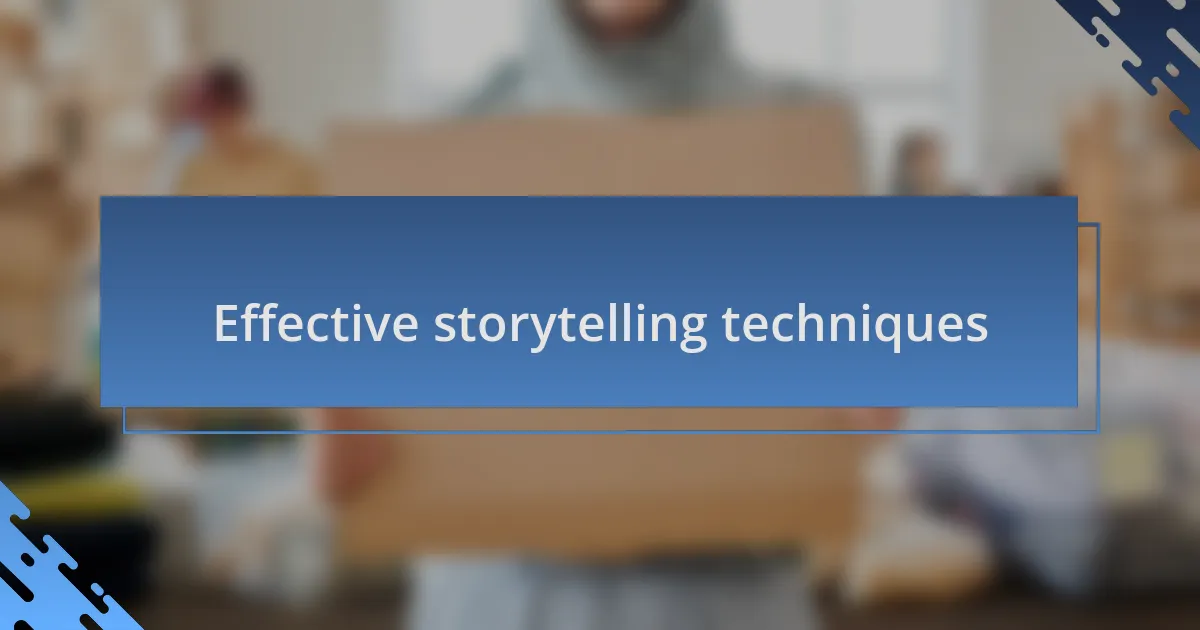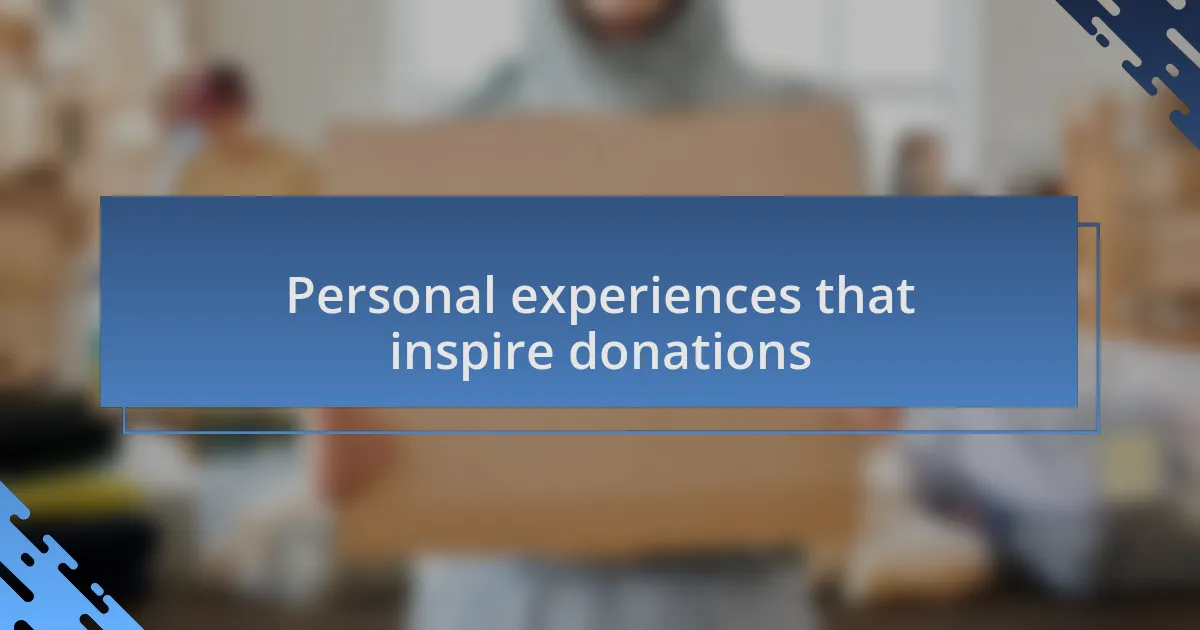Key takeaways:
- Effective homeless charity work requires empathy, connection, and collaboration among organizations to address root causes of homelessness.
- Storytelling is crucial in charity work as it evokes empathy, helps visualize impact, and motivates donors to take action.
- Authenticity and vivid imagery enhance storytelling effectiveness, making issues more relatable and inspiring potential donors.
- Personal experiences shared by individuals in need can profoundly impact donors, fostering a sense of connection and prompting meaningful contributions.

Understanding homeless charity work
Homeless charity work goes beyond simply providing food and shelter; it’s about addressing the underlying causes that lead to homelessness. I remember once volunteering with a local charity that focused on job training programs. Listening to the stories of participants transformed my understanding of their situations. Their resilience in the face of adversity was inspiring, yet it raised a question in my mind: How can we build systems that support these individuals more effectively?
In my experience, effective homeless charity work requires empathy and genuine connection. I once met a woman named Sarah, who had fallen into homelessness after a medical emergency left her struggling financially. Hearing her story made me realize how fragile our circumstances can be. It made me wonder: what would happen if we all took a moment to listen to someone’s journey rather than judgment?
Collaboration among various organizations is essential. I recall a project where different charities came together to provide a comprehensive support system for those in need. The impact was profound; people were not just receiving aid but were also being connected with mental health services and housing options. Could such partnerships be the key to truly breaking the cycle of homelessness?

Importance of storytelling in charity
Storytelling is a powerful tool in charity work, particularly for homeless initiatives. I once attended a fundraising event where a former homeless individual shared his journey from despair to hope. Hearing his words not only captivated the audience but also painted a vivid backdrop that statistics alone could never achieve. Have you ever wondered why we remember stories more than figures? It’s because stories provoke empathy and connection—essential elements in inspiring donations.
In my experience, when donors hear personal narratives, they can visualize the impact of their contributions more clearly. At a community meeting, I remember a woman recounting the moment she found solace at a shelter. She described how a simple act of kindness transformed her life. It struck me that each story is like a thread, weaving together the fabric of shared humanity. How can we ignore such poignant reminders of our interconnectedness?
Moreover, storytelling has an inherent ability to ignite motivation. A colleague once shared how she used stories in her outreach efforts to convey the urgency of support. Every account of resilience and recovery energized the room, prompting conversations about how each person could contribute. Isn’t it fascinating how a well-told story can shift perspectives and inspire action? For me, that’s the magic of storytelling—it not only informs but also moves us to act.

Effective storytelling techniques
When it comes to effective storytelling, I’ve found that authenticity stands out above all. I once spoke with a volunteer who recounted her experience working with homeless youth. She shared not just the successes but also the challenges, allowing her audience to feel both the joy and the heartache. Isn’t it fascinating how honesty can forge a deeper connection with listeners? Authenticity doesn’t just build trust; it invites donors to become part of the story, rather than mere onlookers.
Another technique I’ve embraced is to create vivid imagery through descriptive language. I recall writing a piece about a cold winter night in the city—the biting chills, the faint flicker of makeshift campfires, and the weary faces huddled together. These details prompted readers to visualize the scene and feel compelled to act. Wouldn’t you agree that when you can picture someone’s struggle, your compassion automatically deepens? It’s this kind of imagery that transforms abstract issues into relatable human experiences.
Lastly, weaving in a call to action can be incredibly potent. I experienced this firsthand when crafting a narrative for a fundraising campaign. At the climax of the story, I posed the question: “What if it was your child in need of warmth and shelter?” This poignant moment not only stirred emotion but ignited a sense of urgency among the audience. I believe that a well-structured story, when paired with a compelling call to action, can spur potential donors to make a difference. Don’t you think this approach enhances the story’s overall impact?

Personal experiences that inspire donations
I remember a time when I volunteered at a local shelter during the holidays. One evening, I chatted with a young man who had recently lost his job and home; he shared his dreams of starting over. His vulnerability and hope were palpable, and it struck me how sharing such personal stories could illuminate the very real struggles faced by many. How could anyone hear his story and not feel moved to help?
There was another instance when I met a woman who had been homeless for years but found solace in writing. She shared her heartfelt poems with us, revealing the depth of her experiences—loneliness, despair, and resilience. Listening to her recite those words, I felt a profound connection; it became evident that personal stories could evoke empathy and inspire action. Can you think of a story you’ve heard that changed your perspective?
On a particularly rainy day, I decided to bring in some warm blankets and hot chocolate to distribute. As I handed a steaming cup to an older gentleman, he shared how such small acts of kindness could change his outlook on life. His appreciation was so genuine that it made me realize how impactful even brief encounters could be. It reinforced my belief that when we share these moments of connection, we can inspire others to contribute to the cause in meaningful ways.

Success stories from donors
It’s incredible to witness how myriad small gestures can grow into significant support. A friend of mine once shared how a simple story he heard during a fundraising event inspired him to donate his entire bonus to a local charity. The heartfelt testimony of a formerly homeless individual, detailing their journey from despair to stability, struck a chord with him. Isn’t it fascinating how one person’s experience can ripple through the lives of others like this?
I recall another remarkable instance where a donor decided to host a community dinner after hearing about hardships faced by the homeless in our city. She felt that sharing a meal while listening to their stories would create a bond and encourage others to give. Her initiative grew beyond her expectations, bringing together dozens of people, all eager to contribute, proving how a personal story can mobilize collective action. Have you ever felt encouraged to act after hearing someone’s journey?
What truly stands out to me is the case of a couple who, moved by the stories they encountered on our website, began a weekly donation habit. They would often share feedback about how learning about specific individuals fueled their commitment to giving. Each month, they looked forward to updates, eager to hear how their contributions made a difference. Isn’t it inspiring how informed giving can transform the act of donating into a deeply personal journey?